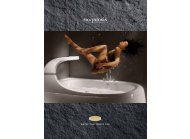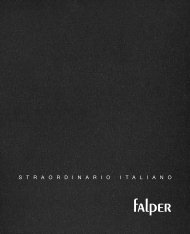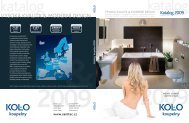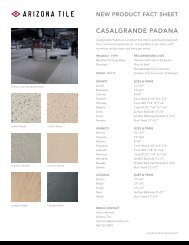DORNBRACHT - Butterfly Trading
DORNBRACHT - Butterfly Trading
DORNBRACHT - Butterfly Trading
Create successful ePaper yourself
Turn your PDF publications into a flip-book with our unique Google optimized e-Paper software.
<strong>DORNBRACHT</strong> the SPIRITof WATER Design as a part of culture and society<br />
COME OF AGE<br />
AT LAST?<br />
I am small, my heart is pure.At first, before I had<br />
a proper name, my parents had big plans for me:<br />
I was to change the world, create a new society,<br />
improve living conditions for the general public,<br />
reconcile the classes with one another. I was to<br />
be the founder of a new era.<br />
With industrialisation the entire known product<br />
culture was thrown into disarray. Gradually<br />
machine-made, mass-produced goods began to<br />
take the place of products which for centuries had<br />
been made by hand and more or less on an individual<br />
basis. To allay people’s anxiety towards the<br />
new industrial products, at first they were concealed<br />
beneath familiar historicised ornaments.<br />
Soon however a designer avant-garde recognised its<br />
own aesthetics of practical industrial form and with<br />
180<br />
FIG. 02<br />
“WG24”<br />
it the social opportunities in the new production<br />
facilities: at last not only the rich but everyone<br />
could enjoy good things. With the release from<br />
historicism at the end of the 19 th century, the<br />
young discipline seemed to have found its destiny:<br />
Design sought practical form and the expression<br />
of a new era. Whether Werkbund or Bauhaus –<br />
design still saw itself as the spearhead of a new<br />
society and wanted to improve living conditions<br />
for the general public.<br />
FIG. 03<br />
“E1027”<br />
Now I have to be sensible. Earlier, when I had<br />
barely come of age, I was suddenly confronted<br />
with enormous challenges: after the war help<br />
was needed quickly, well-considered, sensible<br />
action was needed, not frippery. I had found a<br />
goal, and made common sense the maxim of<br />
my action.<br />
The School of Design in Ulm, founded after<br />
WWII, also saw itself as the new democratic<br />
beginning with which society was to regenerate<br />
itself. With the emphasis on function, its minimalism<br />
and rationality, the School of Design<br />
characterised the image of modernity. “Good<br />
Design”, with little emotion, functional, timeless<br />
and sensible, was for decades to be synonymous<br />
with design. This austerity, however, was not to<br />
the taste of the masses, who certainly had no wish<br />
to live in meagre residential complexes but still<br />
wanted to boast and demonstrate that they had<br />
achieved status and could afford to spend money<br />
again. However the subtle reduction and the<br />
emptiness of modernity became the symbol of<br />
distinction, minimalism became luxury. So design<br />
withdrew from its original goals and became,<br />
without realising it, an object of an intellectual<br />
minority.<br />
I let rip, I want to have fun. I no longer wanted<br />
to be sensible. All society’s demands, all that was<br />
rational and respectable could go to blazes. Off<br />
to pastures new! Away with the old! Give me the<br />
new, the different, the unusual! I had no interest<br />
in what most people thought. I soon discovered<br />
the world of the rich and beautiful and felt fine<br />
there for a while.<br />
Soon the rebellion against functionalism, reason<br />
and sobriety began. The bright colours and interior<br />
designs of the sixties and seventies represented<br />
FIG. 04<br />
“Ulmer Hocker”<br />
an era that wanted to try out new ways of living<br />
together leaving conventions behind. The functionalist<br />
maxim “form follows function” was replaced<br />
by “form follows fun” or “form follows<br />
emotion”. The strident designs of the eighties<br />
finally broke once and for all with the ideas of<br />
functionalism. Although mostly thought of as a<br />
criticism of the dogma of good form, the image<br />
arose in society of a superficial lifestyle discipline,<br />
subsequently aesthetically enhanced, but actually<br />
a dispensable luxury. Design became a meaningless<br />
stylistic term describing everything from “designer<br />
furniture” to “designer clothes” that was out of the<br />
ordinary, was particularly expensive or had been<br />
meaninglessly aestheticised – just as if everything<br />
else had not been designed. Design became the<br />
expression of the world of the superficial.<br />
Nobody is an island. I realised that rebellion is not<br />
a long-term option. And life in the trendy world<br />
gave me no satisfaction either. Perhaps the plans<br />
my parents had for me were not all so bad after<br />
all? Yet times had changed. What ideals can you<br />
fight for now? How can you enrich the world?<br />
The fight against functionalism has been fought,<br />
the dogmas are water under the bridge. Even the<br />
question of where design fitted in between art and<br />
craftsmanship no longer seemed relevant for a<br />
discipline that – just like every other cultural art<br />
form – can no longer be perceived as uniform: the<br />
boundaries between product design, architecture,<br />
fashion, graphics or New Media have become<br />
fluid. With the “New Simplicity” of the nineties<br />
for the first time design returned to its formal<br />
roots, but without reviving the dogmatism. The<br />
new unexciting forms primarily represented the<br />
need for peace in a period which was becoming<br />
increasingly confusing as the result of globalisation<br />
and New Media.<br />
In fact the long-derided discipline was being taken<br />
more seriously as a factor in the fight for market<br />
shares, but at the same time had lost its independence<br />
to marketing. Yet the attempts to measure<br />
design exclusively by successful sales and lifestyles<br />
is being compared by more and more designers<br />
to an approach that does not fit so well in<br />
the marketing specifications: they have set off in<br />
search of content and a new symbolism which no<br />
longer wishes to be neutral but sees subjectivity<br />
as a quality. A young designer generation can<br />
evidently easily combine digital technologies and<br />
new forms with old ornaments, with what is handmade,<br />
traditional, knitted, embroidered, woven<br />
and tucked. It has discovered the value of the stories<br />
things tell us about our culture: from ageing,<br />
custom and usage, rituals and actions. From its<br />
origins and the history of development of the individual<br />
product category. From the wealth of old<br />
craftwork techniques and the ornamental objects<br />
of various cultures, eras and places. From inventors,<br />
designers and enterprises, from predecessors<br />
and archetypes. And so the pattern on the case of<br />
a Dior lipstick tells of the wickerwork of the stools<br />
on which the customers of the Paris fashion house<br />
have been sitting for 60 years. The vase designs of<br />
Hella Jongerius for Ikea reflect traditional ornaments<br />
from all over the world. The Opel designers<br />
conceal a little shark on the glove compartment<br />
of the new Corsa, this allegedly having been<br />
smuggled past all the inspection points of the car<br />
manufacturer, making it all the more charming.<br />
References to archetypical product forms or<br />
homage to historical objects can be seen in the<br />
highly innovative designs of Konstantin Grcic.<br />
Patricia Urquiola ruches her seating articles to<br />
give the effect of blossoms. Kitchens or bathrooms<br />
are no longer accumulations of isolated design<br />
objects but are becoming ritual sites for the user.<br />
Of course design continues to serve commerce,<br />
the changing trends and fashions: from the New<br />
Simplicity and Retro trend, a new digital hightech<br />
aesthetic through to a new bourgeoisie, currently<br />
seen on all sides. Yet only now are many<br />
people beginning to realise that changing styles<br />
need not necessarily mean the opposite of design:<br />
even the steel tubing furniture of the twenties or<br />
the simple box-style designs of post-war modernism,<br />
indeed all “design classics” are children of<br />
their time, who only gain in character through<br />
their history. The contemporaneity of different<br />
styles is also the expression of cultural abundance<br />
and ambivalent social conditions: a high-tech<br />
ornament may be just as much the expression<br />
of the fascination for the new technologies as a<br />
reaction to a threat emanating from them. Trends<br />
and fashions are considered to be signs of our<br />
changing society, without having to dispense with<br />
all that has been here so far. And so realisation is<br />
finally dawning that it is not only articles which<br />
match the idea of a plain, bright chrome “design<br />
style” that are designed, but that the gold-plated<br />
curved tap was also a design once and has a story<br />
to tell.<br />
Whether these approaches represent a real rethinking<br />
for the industry, only time will tell, in the<br />
future where design also has to appreciate its<br />
responsibility for the consequences of unbridled<br />
consumption, globalisation, for production conditions,<br />
ecological questions and the new demands<br />
of the information society. But it appears that a<br />
start has been made: design has begun to free<br />
itself from the role of marketing instrument, to<br />
rediscover its independence and to communicate<br />
that it does not only serve consumption, but<br />
is connected to social developments: as an expression<br />
of topical conditions and requirements,<br />
anxieties and possibilities, fears and hopes for the<br />
future. It is beginning to see its role as an orientation<br />
discipline and again wants to stand for content,<br />
provide meaning and identity. It has found a<br />
new way to access its own history and no longer<br />
<strong>DORNBRACHT</strong> the SPIRITof WATER Design as a part of culture and society<br />
FIG. 05<br />
“670”<br />
needs to rediscover everything. It sees itself as<br />
part of culture and society. Perhaps design is<br />
coming of age.<br />
FINALMENTE<br />
ADULTO?<br />
Sono giovane e dal cuore puro. Agli inizi, ancor<br />
prima che fosse deciso il mio nome, i miei genitori<br />
nutrivano grandi speranze per me. Avrei<br />
cambiato il mondo, avrei fondato una nuova<br />
società, migliorato le condizioni di vita di masse<br />
immense di persone, riconciliato le classi tra di<br />
loro. Sarei diventato il fondatore di una nuova<br />
epoca.<br />
181


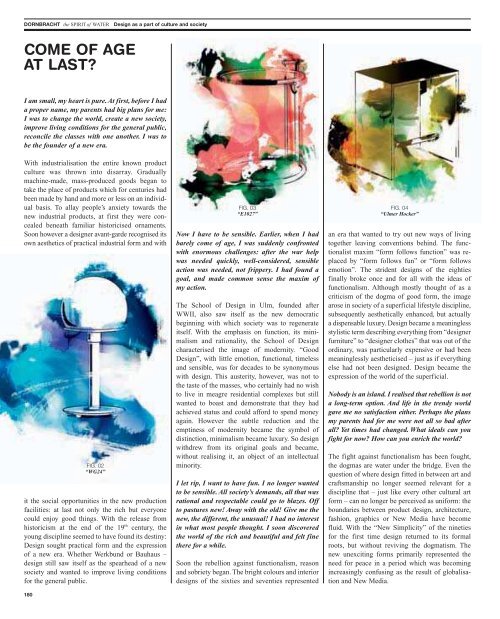


![Katalog USAKANG retro vany [ pdf, 0.6 MB ] - Butterfly Trading](https://img.yumpu.com/47275139/1/190x134/katalog-usakang-retro-vany-pdf-06-mb-butterfly-trading.jpg?quality=85)
